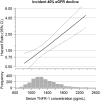Association of Soluble TNFR-1 Concentrations with Long-Term Decline in Kidney Function: The Multi-Ethnic Study of Atherosclerosis
- PMID: 30287518
- PMCID: PMC6218870
- DOI: 10.1681/ASN.2018070719
Association of Soluble TNFR-1 Concentrations with Long-Term Decline in Kidney Function: The Multi-Ethnic Study of Atherosclerosis
Abstract
Background: TNF receptor-1 (TNFR-1), which plays a causative role in endothelial cell dysfunction and inflammation, is expressed on the cell surface in glomerular and peritubular capillary endothelium of the kidneys. Higher soluble TNF receptor-1 (sTNFR-1) concentrations are associated with kidney disease progression among persons with established diabetic kidney disease. However, no studies have assessed sTNFR-1's role in long-term kidney function changes in a multiethnic population without cardiovascular disease at baseline.
Methods: We tested associations between baseline sTNFR-1 concentrations and 10-year decline in eGFR (incident ≥40% decline and annual proportional decline) among 2548 participants in the Multi-Ethnic Study of Atherosclerosis (MESA), a prospective cohort study. Serum creatinine concentrations were determined at enrollment and study years 3, 5, and 10.
Results: Mean age of participants was 61 years old, 53% were women, and mean baseline eGFR was 79 ml/min per 1.73 m2. Serum sTNFR-1 was inversely associated with baseline eGFR. Over median follow-up of 9.3 years, 110 participants developed ≥40% decline in eGFR; each SD higher concentration of sTNFR1 was associated with higher risk of 40% eGFR decline (adjusted hazard ratio, 1.43; 95% confidence interval [95% CI], 1.16 to 1.77; P<0.001). The highest sTNFR-1 tertile was associated with adjusted annualized decline in eGFR of 1.94% (95% CI, 1.79 to 2.09). Associations persisted across subgroups defined by demographics, hypertension, diabetes, and baseline CKD status.
Conclusions: Elevated serum sTNFR-1 concentrations are associated with faster declines in eGFR over the course of a decade in a multiethnic population, independent of previously known risk factors for kidney disease progression.
Keywords: Chronic inflammation; chronic renal disease; endothelium; soluble tumor necrosis factor receptor-1.
Copyright © 2018 by the American Society of Nephrology.
Figures



References
-
- Cunningham PN, Dyanov HM, Park P, Wang J, Newell KA, Quigg RJ: Acute renal failure in endotoxemia is caused by TNF acting directly on TNF receptor-1 in kidney. J Immunol 168: 5817–5823, 2002 - PubMed
Publication types
MeSH terms
Substances
Grants and funding
- N01 HC095161/HL/NHLBI NIH HHS/United States
- N01 HC095168/HL/NHLBI NIH HHS/United States
- F32 DK112532/DK/NIDDK NIH HHS/United States
- N01 HC095167/HL/NHLBI NIH HHS/United States
- N01 HC095159/HL/NHLBI NIH HHS/United States
- UL1 TR001420/TR/NCATS NIH HHS/United States
- N01 HC095163/HL/NHLBI NIH HHS/United States
- HHSN268201500003I/HL/NHLBI NIH HHS/United States
- UL1 TR000040/TR/NCATS NIH HHS/United States
- N01 HC095166/HL/NHLBI NIH HHS/United States
- N01 HC095162/HL/NHLBI NIH HHS/United States
- N01 HC095160/HL/NHLBI NIH HHS/United States
- K24 DK103986/DK/NIDDK NIH HHS/United States
- HHSN268201500003C/HL/NHLBI NIH HHS/United States
- UL1 TR001079/TR/NCATS NIH HHS/United States
- N01 HC095169/HL/NHLBI NIH HHS/United States
- N01 HC095165/HL/NHLBI NIH HHS/United States
- N01 HC095164/HL/NHLBI NIH HHS/United States
LinkOut - more resources
Full Text Sources
Medical
Research Materials
Miscellaneous

